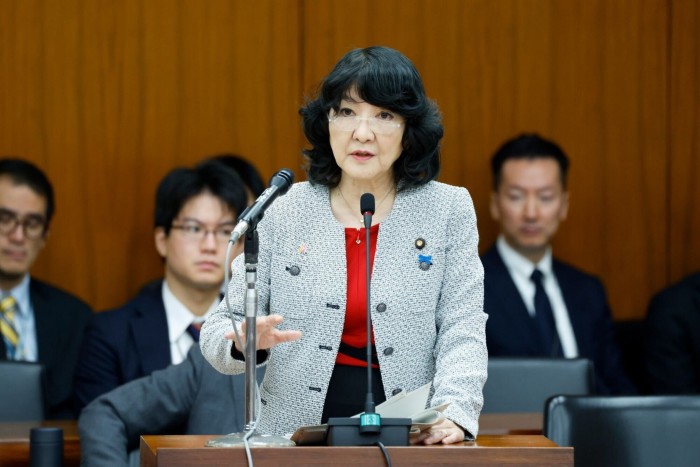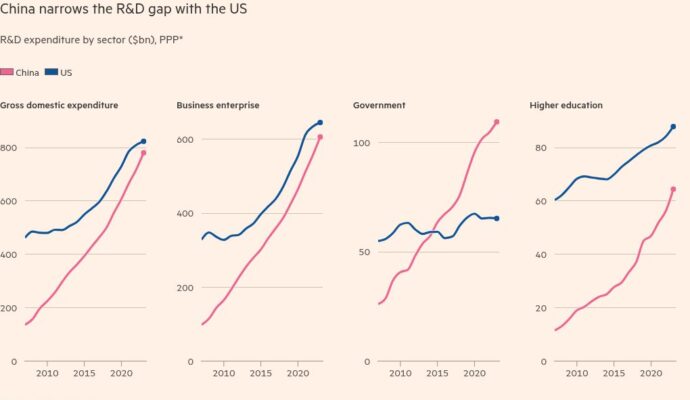Unlock the Editor’s Digest for free
Roula Khalaf, Editor of the FT, selects her favourite stories in this weekly newsletter.
Japan has launched its own version of Donald Trump’s cost-cutting Department of Government Efficiency, a move that could help ease financial market concerns about Prime Minister Sanae Takaichi’s spending plans.
Creation of a “Doge Japan edition” was one of the demands from the reformist Japan Innovation party ahead of the coalition agreement with Takaichi’s Liberal Democratic party that sealed her election as the nation’s first female prime minister last month.
The launch of the department came the week after Takaichi unveiled a ¥21.3tn ($135.4bn) stimulus package designed to spur economic growth and shield households from the rising cost of living.
The raft of planned spending — from gas and electricity subsidies to cash handouts for parents and rice coupons — has spooked markets, sending bond yields up and weakening the yen to the point where traders are expecting the government to intervene to stabilise the currency.
Officially named the Office for Review of Special Tax Measures and Subsidies, the government body could help calm investors, analysts said.
“Now that the financial markets have become concerned about Takaichi’s fiscal expansion and the long-term risk to the yen . . . her administration is becoming more sensitive to the risk of a bad reputation,” said Takahide Kiuchi, executive economist at the Nomura Research Institute. “Doge is maybe a way of reducing this kind of stigma.”
The problem, Kiuchi added, was that fundamentally “Takaichi does not want to make government more efficient, she wants to be expansionary”.
By agreeing the creation of a body that nods to the US Doge, analysts say that Takaichi could also be signalling support for Trump, a crucial ally, even though many of her spending plans are designed to offset the impact of the president’s trade tariffs.
Earlier this year Trump imposed tariffs of 25 per cent on imports from Japan, before later cutting them to 15 per cent in return for promises of investment in the US.
But the comparisons between the US and Japanese versions of Doge do not extend very far past the idea that both notionally seek to make government more efficient. Japan is not planning to install its own Elon Musk to lead the cost-cutting efforts. Its office is led by the prime minister and managed by the finance minister.

At a news conference on Tuesday announcing the launch of the Japanese office, finance minister Satsuki Katayama played down the idea of an explicit goal like the $2tn of savings that Musk once targeted.
Underlining the public relations element of the office, the government plans a consultation on where cuts and savings could be made.
“The public can have its say about what is wasteful. What subsidies? Is the budget going wrong? What tax breaks do you think are unnecessary?” said Katayama, whose support is needed by Takaichi if she wants to implement her spending plans.
Already, suggestions have poured in under Katayama’s posts announcing the office on social media site X, including defunding national broadcaster NHK and cutting grants to private space companies — although such moves appear beyond the new office’s remit.
So far, the government has only said it will target special tax breaks for companies, subsidies and specific state funds.
In February, a finance ministry report to parliament said that in the 2023-24 fiscal year, almost 1.5mn companies submitted applications for favourable tax treatment, with credits reaching ¥1.7tn.
Takero Doi, professor of economics at Keio University, said spending cuts were needed. “Fiscal spending increased dramatically during the Covid-19 pandemic and . . . has not been reduced back to pre-pandemic levels,” Doi said.
Experts are reserving broader judgment on the new office until they can see how effective it is.
“In the long term, the government should be more efficient, and maybe Japan’s Doge can cut wasteful spending. I hope so but no one knows how long Doge will survive. In the case of the US, it didn’t last one year,” said Kiuchi, referring to reports, denied by the so-called department, that it was no longer functioning.
Japan’s national and local authorities have often been criticised for wasteful and extravagant spending, particularly on infrastructure, both during the pre-1989 credit bubble and efforts in the following decades to stimulate economic growth.
Tobias Harris, founder of the Japan Foresight consultancy, said previous Japanese prime ministers had tried similar initiatives. “It’s like this version of Doge gives it a new paint job,” Harris said.


